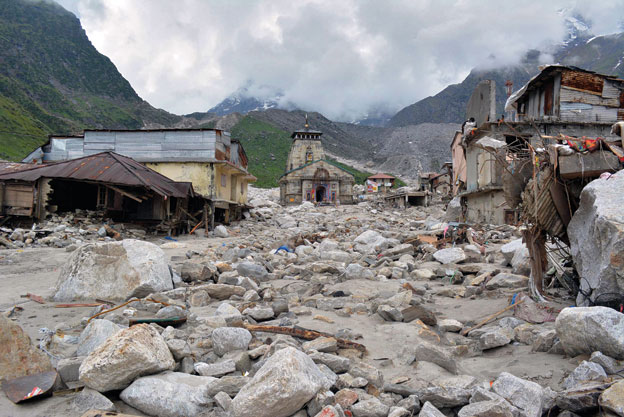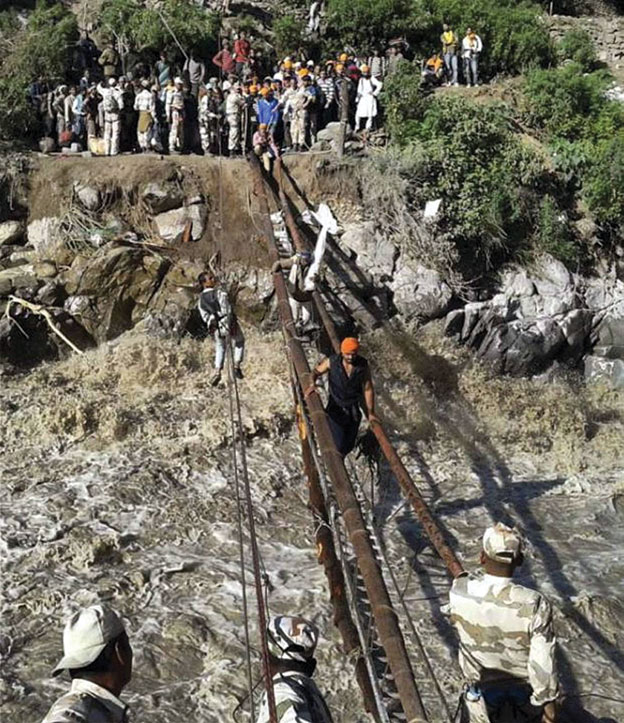COVER STORY:
The Uttarakhand Catastrophe: Man-Aggravated Natural Disaster
Last month, India faced the wrath of Mother Nature as cloudbursts over Kedarnath and Rambada, in the northern state of Uttarakhand, brought in flash floods and land slides of humongous proportions that swept away entire towns and villages. Roads, bridges, and lines of communication broke down and countless were lives lost and those still alive, were in peril of succumbing soon. Though it was deemed ‘an act of Nature’ by the government, the magnitude of the calamity could have been a lot less if the government had acted soon enough. To add insult to the injury, the government took almost a week before any help was made available.
As it stands, the only choice for India to minimize cataclysmic climatic disasters, is to practice sustainable growth and regulated development, or face a future with recurrent furies of Mother Nature, writes Priyanka Bhardwaj.

(Above): The Kedarnath Temple (c) is pictured amid damaged surroundings by flood waters at Rudraprayag in the Himalayan state of Uttarakhand, June 20. India’s monsoon rains could ease soon after hitting 89 percent over averages in the week to June 19, according to weather office sources, in a third straight week of downpours that have caused major flooding in north India. This picture was taken on June 20. [Photo: Reuters]
The state of Uttarakhand, also known as the “Land of Gods,” is home to multiple temples and pilgrimage sites for people of different faiths, particularly Hindus and Sikhs. Scenic beauty, majestic Himalayan mountain ranges, forests, and the glacial origin of two rivers that feed northern India, the Ganga and Yamuna, also lie in this state.
Though familiar with heavy downpours, the state faced its worst calamity ever recorded in recent times. According to the chief long-range forecaster of the meteorological department, S. Damodar Pai, the Westerlies that unleashed unprecedented havoc in Europe, came through Afghanistan, collided with the south west Monsoons and produced deadly cloudbursts and abnormally high levels of rains.
As has often been the norm with any Indian central or state government, they tried to attribute the cause of this havoc to the ‘fury of Mother Nature’ and initially expected rains to stop thus losing precious time.
For a rather long period neither was an emergency declared by the state’s chief minister, Vijay Bahuguna, nor did he call for help from other states, the center, or international organizations.
Environmentalists, activists and citizens uniformly denounce the ineptness of the government to tackle the disaster. According to them, rampant commercialization of the entire region without paying any regard to ecology, so much so, that concrete structures have come up right on river banks leaving no space for the meandering of rivers, is largely to blame for the massive loss of life and property in this disaster.

(Above): A view of damaged houses after floods hit in Uttarakhand. The houses seem to be too close to the river than what should be allowed.. [Photo: PTI]
The region has been faced with unregulated concretization, deforestation and mining (even illegal at times). Housing and hotel development along the riverbanks and an uncontrolled number of tourists visiting the state for the Char Dham Yatra (pilgrimage) as well as the Himalayas, are some of the other factors that can be blamed for the environmental degradation of the region.
At the time of floods, while the population of the state stood at ten million, the number of visitors was well over what should have been allowed as a healthy count.
The Comptroller and Auditor General, in its April report, had clearly shown that the state was completely unprepared to handle any calamity.
It was conveniently overlooked by the state government, just like in December 2012, the Ministry of Environment and Forests’ call for declaration of an 83 mile-long stretch along the river Ganga as an eco-sensitive zone, that included a ban on construction alongside the river, was vetoed against by the state ministry.
Successive state governments have tended to tilt in favor of locals ‘lobby,’ which translates to mafia, industrial, mining, and construction groups, who grease the palms of policy framers to squash or tweak green policies to be finally declared as “anti-development.”
Though late, but one hears from the corridors of power, that current Minister for Environment and Forests, Jayanthi Natarajan, may once again make a pitch for revision of the December 2012 order.
The cloudbursts over Kedarnath and Rambada in Uttarakhand, Jun. 16, turned fatal as they produced huge columns of water, falling from the sky with a destructible force that crashed against mountains, loosened rocks and boulders, and swept them and everything else that was in the path, in its swell and surge.
Official estimates peg the number of dead to more than 5,000 and the number of stranded or missing pilgrims and locals at more than 15,000. The estimates have been increasing every day since Jun. 17.
While all this was still happening, state authorities and politicians went on futile aerial surveys of the region, without really coming up with an action plan to evacuate those stranded. As a result, precious time was lost in the beginning.

(Above): Indo Tibetan Border Police rescue people by building temporary bridges in the disaster-hit region of Uttarakhand. [Photo: PTI]
The Indian Army, Indian Air Force, the Indo Tibetan Border Police, state police and Navy commandos called ‘Marcos’ joined forces to eventually embark on a heroic rescue operation of massive proportions.
Rescue agencies fished out dead bodies from layers of slush and debris and evacuated people stranded in the far, isolated areas of the mountains despite the dense fog, fresh spells of rains, inclement weather, landslides, and overcast conditions continuing to damage, submerge and wash away sections of roadways thereby crippling rescue work and forcing choppers and ambulances to return to their bases.
Two important road links to Rudraprayag were completely washed jeopardizing traffic movement to Tehri.
Acting as lifesavers, drones (unmanned aerial vehicles), mainly used for bombings at the Afghanistan-Pakistan border, were deployed to obtain images of people stuck on mountain tops for 37 helicopters to ferry them to safer locales.
As of Jun. 24, National Disaster Response Force (NDRF) personnel had combed Kedarnath and its surrounding jungles, Son Prayag, Guptakashi, Gaurikund and Rambada.
Ram Prasad was part of one of the NDRF teams. He said that incessant cloudbursts, weeklong torrential rains, cold weather, lack of warm clothing, food, and shelter were primarily responsible for casualties among the initial survivors of the floods.
The initial focus was to rescue over a 1,000 people stranded in Chamoli district and Gangotri valley and then the Badrinath and Harsil areas were targeted as per state chief secretary Subhash Kumar.
A huge sense of relief was felt by Yaron Ben Israel and his family when they received news of survival of their son, Nadav Ben, after a week-long agonizing wait. Nadav, who was caught in the floods, trekked about 62 miles of treacherous terrain with a friend to find shelter in a makeshift Army relief camp.
Sudesh Makkar and four more senior citizens from Gurgaon are indebted for the help they received from villagers of Burari and the old keeper of a hotel who sheltered and fed them for four days, till army jawans arrived to evacuate them.
Others like M.N. Srivastava and his family were lucky to have missed the fatal tirath yatra (pilgrimage) that they would have otherwise undertaken, all thanks to last minute changes in the schedule of his Singapore-based son.
Manish Kumar however, will have to live through the trauma of not being able to save his wife. She fell into a gorge when a landslide hit them near the Jungle Chatti area.
Besides the government’s allocation of an additional 4,000 tons of wheat and rice at an economic cost (which includes minimum support price plus storage and procurement charges), individual donations for supplies of ready-to-eat and ready-to-constitute food, medicines, torches, raincoats, umbrellas and blankets have slowly started reaching the state.
Meanwhile, Indian Railways will be carrying food, clothing, utensils, building material, free of cost from Jun. 25 to July 9, while several transport agencies like Transport Nagar have volunteered to carry relief material, and many volunteers have reached the state to assist in relief work.
As for medical aid, Dr G.C. Joshi, acting health director general, says that chlorine balls for water treatment and bleaching powder to oxidize dead bodies have been dispatched to affected areas in order to prevent an epidemic outbreak.
State authorities have appealed to the relatives of victims and those reportedly stranded or missing to keep faith and patience and look out for lists of missing or surviving people.
Google’s Person Finder can also be accessed for the purpose.
Meanwhile, the government has ordered for a mass cremation of bodies after their identification, post mortem and DNA preservation formalities.
The danger has not yet abated. The Central Water Commission has sounded warning bells for the possibility of Tehri and Ramganga dams overflowing with water levels already reaching 449 percent above normal, the highest in the country. If rains do not recede, excess water will need to be discharged by opening the sluice gates, which could amount to imminent flooding in downstream areas.
The government meanwhile announced that the rescue work was complete, Jun. 27. It was now time for relief and rehabilitation of the entire region currently estimated to take at least three long years!
As for the pilgrims, traditional puja or worship of Lord Shiva of the Kedarnath temple has been restored at Uknimath, while the Hemkunt Sahib shrine remains closed to pilgrims for now.
India’s woes have never been new and solutions have been very commonplace but lack of will on part of legislating and executing authorities has impeded proper planning and implementation.
For quite sometime, Dr. Sunita Narain, environmentalist and director general of Center for Science and Environment, has argued against the logic of having 70 dams built on the Ganga river in the state.
The country’s leadership need to be accountable and step up.
As it stands, the only choice for India to minimize cataclysmic climatic disasters, is to practice sustainable growth and regulated development, or face a future with recurrent furies of Mother Nature.
|